|
|
 |
 |
 |
 |
 |
 |
 |
 |
 |
|
|
 |
 |
 |
 |
Saturday Night Style
Some ballroom dances were formal affairs with long gloves and evening gowns, but as dancing became a more regular form of recreation, dress codes relaxed to include simpler cocktail attire. A lady's typical Saturday Night Look might include these key ingredients.
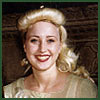 A popular hairstyle of the era involved pin-curled bangs with hair pulled back on the side and falling in cascading waves onto the neck. Because fabric had to be preserved at all costs, hats and hair bows were replaced by hairpins and fresh flowers. Styles were often held in place with "hair lacquer," a popular product costing about 60 cents a bottle.
A popular hairstyle of the era involved pin-curled bangs with hair pulled back on the side and falling in cascading waves onto the neck. Because fabric had to be preserved at all costs, hats and hair bows were replaced by hairpins and fresh flowers. Styles were often held in place with "hair lacquer," a popular product costing about 60 cents a bottle.
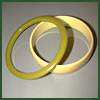 Accessories were an important way to dress up an outfit for an evening out on the town. Because pearls and locket chains were considered expensive and fragile, they were usually saved for special occasions. Most women wore a cheaper alternative: Bakelite jewelry was made from a pretty, colorful plastic.
Accessories were an important way to dress up an outfit for an evening out on the town. Because pearls and locket chains were considered expensive and fragile, they were usually saved for special occasions. Most women wore a cheaper alternative: Bakelite jewelry was made from a pretty, colorful plastic.
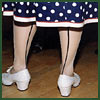 Clothing coupons were hard to come by during the war years, but silk stockings were the sacrificial lamb -- they were banned in 1941. The cosmetics industry quickly introduced "cosmetic stockings," leg makeup that was a liquid foundation rubbed onto the legs to simulate the look of stockings. The illusion was finished off with a line drawn up the back of the leg with an eyebrow pencil to create the impression of a seam. Clothing coupons were hard to come by during the war years, but silk stockings were the sacrificial lamb -- they were banned in 1941. The cosmetics industry quickly introduced "cosmetic stockings," leg makeup that was a liquid foundation rubbed onto the legs to simulate the look of stockings. The illusion was finished off with a line drawn up the back of the leg with an eyebrow pencil to create the impression of a seam.
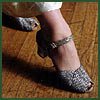 Sling-back pumps with open toes were a popular shoe style for dancing. During the war years, U.S. rationing rules limited the height of shoe heels to one inch. Because of a world shortage in leather, every imaginable material was incorporated into shoes, including reptile skins and wooden soles. Women often created their own festive shoe decorations out of household items like pipe cleaners and recycled buttons. Sling-back pumps with open toes were a popular shoe style for dancing. During the war years, U.S. rationing rules limited the height of shoe heels to one inch. Because of a world shortage in leather, every imaginable material was incorporated into shoes, including reptile skins and wooden soles. Women often created their own festive shoe decorations out of household items like pipe cleaners and recycled buttons.
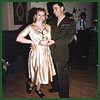 Because there were so many constraints on clothing, necessity became the mother of invention. Dresses were made without zippers or cuffs, and with only enough fabric to create a slightly flowing skirt. Nylon and rayon were introduced as substitutes for cotton. In 1942, Vogue magazine described the new "Clothes From Chemicals": "Nylon, a versatile chemical product which has already been proven in hairbrushes, toothbrushes and the best-wearing stockings in the world, is now being turned into soft, wooly fleeces. These make clothes with almost magic properties." Because there were so many constraints on clothing, necessity became the mother of invention. Dresses were made without zippers or cuffs, and with only enough fabric to create a slightly flowing skirt. Nylon and rayon were introduced as substitutes for cotton. In 1942, Vogue magazine described the new "Clothes From Chemicals": "Nylon, a versatile chemical product which has already been proven in hairbrushes, toothbrushes and the best-wearing stockings in the world, is now being turned into soft, wooly fleeces. These make clothes with almost magic properties."
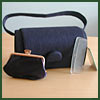 For a typical evening out, a woman's handbag would usually contain at least one lipstick, in a shade such as Regiment Red; a compact; a small handkerchief; one pack of cigarettes; a book of matches; a ration book; house keys; several hairpins; an eyebrow pencil (for touching up her "stockings"); a fountain pen; and possibly a dance card, if used at the ballroom where she planned to kick up her heels that night. For a typical evening out, a woman's handbag would usually contain at least one lipstick, in a shade such as Regiment Red; a compact; a small handkerchief; one pack of cigarettes; a book of matches; a ration book; house keys; several hairpins; an eyebrow pencil (for touching up her "stockings"); a fountain pen; and possibly a dance card, if used at the ballroom where she planned to kick up her heels that night.

|
|
 |
In 1941, a young crooner named Frank Sinatra made his first appearance in the Bay Area, gracing the stage of the enormous and elegant Sweets Ballroom in Oakland. Billed as the "East Bay's Home of the Big Bands" and nicknamed the "Beautiful Ballroom," Sweets was a 12,000-square-foot Baroque Revival dance hall. Opened in 1924, it quickly became one of the best-known and most popular ballrooms in the country. During the 1930s and 1940s, Sweets hosted the most popular bands of the era, including Count Basie, Benny Goodman, Duke Ellington, Glenn Miller, Artie Shaw and Tommy Dorsey. The dance floor could accommodate 1,000 dancers, although crowds sometimes swelled to 5,000 people when the Big Bands were in town!
|
|
 |
Copyright © 2003 KQED, Inc. All Rights Reserved. |
 |
 |
 |
 |
 |
 |
 |
 |
|
|
